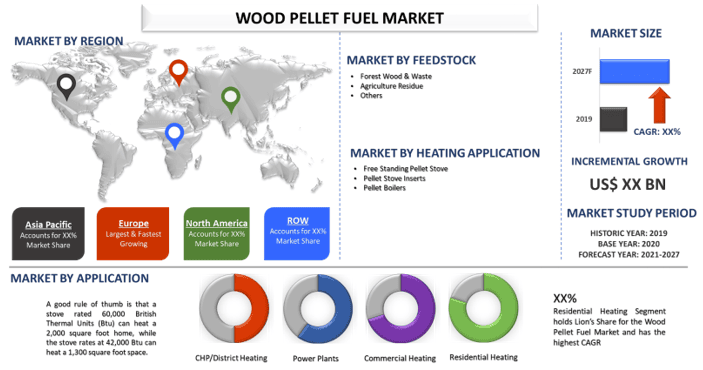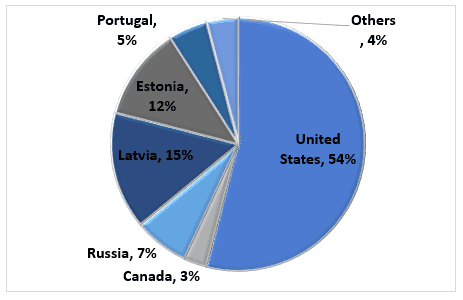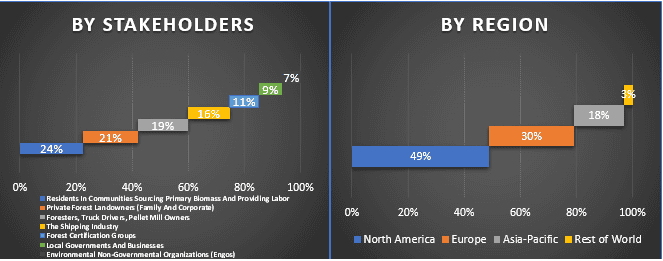- Trang chủ
- Về chúng tôi
- Ngành
- Dịch vụ
- Đọc
- Liên hệ với chúng tôi
Thị trường nhiên liệu viên gỗ nén: Phân tích hiện tại và Dự báo (2021-2027)
Tập trung vào Nguyên liệu đầu vào (Gỗ & Phế thải từ Rừng, Phụ phẩm Nông nghiệp, Loại khác); Ứng dụng Nhiệt (Bếp viên nén độc lập, Lò sưởi viên nén lắp trong, Lò hơi viên nén); Ứng dụng (CHP/Hệ thống sưởi ấm khu vực, Nhà máy điện, Sưởi ấm dân dụng, Sưởi ấm thương mại); Khu vực/Quốc gia

Thị trường nhiên liệu viên gỗ dự kiến sẽ vượt quá định giá thị trường hơn 18 tỷ đô la Mỹ vào năm 2027 và dự kiến sẽ tăng trưởng với tốc độ CAGR đáng kể khoảng 9,5% trong giai đoạn dự báo (2021-2027). Viên gỗ là những mảnh hình trụ nhỏ dài 10-20 mm với đường kính thay đổi từ 5 đến 10 mm được sản xuất từ vỏ cây nghiền mịn. Chúng thường được sử dụng làm nhiên liệu và có thể được tự động nạp vào đầu đốt nhờ hình dạng nhỏ và cố định. Mặt khác, năng lượng được tiêu thụ trong quá trình sấy khô và nghiền vỏ cây được sử dụng để sản xuất viên gỗ. Nhìn chung, tỷ lệ năng lượng đầu ra trên năng lượng đầu vào tương đối cao hơn ở viên gỗ so với dăm gỗ, nhưng viên gỗ có thể được sử dụng hiệu quả trong nhà ở và đốt hiệu quả trong các bếp tương đối nhỏ. Hiệu quả năng lượng của hệ thống sản xuất viên gỗ phải được cải thiện để giảm lượng khí thải nhà kính (GHG) nhằm mở rộng việc sử dụng viên gỗ như một nguồn năng lượng chính.
Đại dịch đã gây ra những ảnh hưởng nghiêm trọng đến thị trường viên gỗ và nền kinh tế nói chung vì nó làm gián đoạn việc làm, vận chuyển, thị trường tài chính và các ngành công nghiệp khác. Khi so sánh các xu hướng và hoạt động từ trước và sau covid-19 của thị trường viên gỗ, tất cả các điều kiện kinh tế, môi trường và xã hội đều được xem xét. Covid-19 ảnh hưởng đến số lượng nhân viên lành nghề sẵn có, vận chuyển sản phẩm và các ngành công nghiệp dọc theo chuỗi cung ứng. Tuy nhiên, mặc dù tổng số việc làm giảm mạnh, nhưng việc làm trong ngành công nghiệp viên nén vẫn tiếp tục tăng trưởng. Điều này là do sự phổ biến ngày càng tăng của năng lượng sinh học dựa trên gỗ và cũng chứng minh rằng chuỗi cung ứng có thể được duy trì bất chấp sự gián đoạn kinh tế toàn cầu lớn. Các nhà phân tích cũng đang kỳ vọng sự tăng trưởng trong quá trình phục hồi năng lượng sinh khối sau đại dịch. Xây dựng lòng tin thông qua sự tham gia hiệu quả là một thách thức để tăng cường khả năng phục hồi của chuỗi cung ứng này và các chuỗi cung ứng dựa trên gỗ khác.
Tỷ lệ sử dụng viên gỗ ở các khu vực khác nhau, năm 2018

Andritz AG, Energex, Rentech, Inc., The Westervelt Company, Enito Singpellet Pte Ltd., F.E. Wood & Sons, Enviva LP, Pinnacle Renewable Energy Group, Wood Pellet Energy (UK) LTD và German Pellets GmbH là một số công ty nổi bật hoạt động trong Thị trường nhiên liệu viên gỗ. Một số thương vụ M&A cùng với quan hệ đối tác đã được thực hiện bởi những người chơi này để tạo điều kiện cho khách hàng với các sản phẩm/công nghệ công nghệ cao và sáng tạo.
Thông tin chi tiết được trình bày trong báo cáo
“Trong số các nguyên liệu thô, phân khúc Gỗ rừng & chất thải chiếm phần lớn”
Dựa trên nguyên liệu thô, thị trường Nhiên liệu viên gỗ được phân thành Gỗ rừng & chất thải, Phế phẩm nông nghiệp và các loại khác. Trong số các nguyên liệu thô, phân khúc Gỗ rừng & chất thải của thị trường được định giá XX tỷ đô la Mỹ vào năm 2020 và có khả năng đạt XX tỷ đô la Mỹ vào năm 2027, tăng trưởng với tốc độ CAGR là XX% từ năm 2021-2027. Nhiên liệu viên cao cấp chứa ít hơn 1% hàm lượng tro và thường được sản xuất từ mùn cưa gỗ cứng hoặc gỗ mềm không chứa vỏ cây. Hàm lượng tro khác nhau trong nhiên liệu cao cấp từ khoảng 0,3% trong một số loại gỗ mềm phía tây đến khoảng 0,7% trong các loại gỗ cứng phía đông. Viên nén cao cấp, chiếm hơn 95% sản lượng viên nén hiện tại và thường có thể được đốt trong bếp.
“Trong số các ứng dụng sưởi ấm, phân khúc Bếp lò viên nén độc lập chiếm phần lớn”
Dựa trên Ứng dụng sưởi ấm, Thị trường nhiên liệu viên gỗ được phân thành Bếp lò viên nén độc lập, Miếng chèn bếp lò viên nén và Nồi hơi viên nén. Trong số các Ứng dụng sưởi ấm, phân khúc Bếp lò viên nén độc lập chiếm định giá thị trường là XX tỷ đô la Mỹ vào năm 2020 và dự kiến sẽ đạt XX tỷ đô la Mỹ vào năm 2027, với tốc độ CAGR là XX% trong giai đoạn được phân tích. Bếp lò sưởi độc lập cần được đổ đầy viên nén và đặt bộ điều nhiệt. Một ống khoan cơ khí đưa viên nén vào một nồi đốt, nơi chúng được đốt ở nhiệt độ cao, tạo ra creosote không làm tắc lỗ thông hơi và rất ít tro hoặc khí thải giúp không khí trong nhà và ngoài trời sạch hơn. Bếp lò viên nén độc lập có hiệu quả gấp đôi so với bếp củi cũ trong việc làm ấm không gian và hiệu quả hơn rất nhiều so với lò sưởi.
“Trong số các ứng dụng, phân khúc Sưởi ấm dân dụng chiếm phần lớn”
Dựa trên Ứng dụng, thị trường Nhiên liệu viên gỗ được phân thành Nhiệt điện kết hợp/Sưởi ấm khu vực, Nhà máy điện, Sưởi ấm dân dụng và Sưởi ấm thương mại. Trong số các ứng dụng, phân khúc Sưởi ấm dân dụng của thị trường được định giá XX tỷ đô la Mỹ vào năm 2020 và có khả năng đạt XX tỷ đô la Mỹ vào năm 2027, tăng trưởng với tốc độ CAGR là XX% từ năm 2021-2027. Một quy tắc ngón tay cái tốt là một bếp lò có công suất 60.000 Đơn vị nhiệt Anh (Btu) có thể sưởi ấm một ngôi nhà rộng 2.000 feet vuông, trong khi bếp lò có công suất 42.000 Btu có thể sưởi ấm một không gian rộng 1.300 feet vuông. Khi một người chọn thiết bị đốt củi hoặc viên nén, điều quan trọng là phải chọn thiết bị có kích thước phù hợp với không gian cần sưởi ấm.
“Châu Âu đại diện cho một trong những thị trường lớn nhất của thị trường Nhiên liệu viên gỗ”
Để hiểu rõ hơn về động lực thị trường của thị trường Nhiên liệu viên gỗ, một phân tích chi tiết đã được tiến hành cho các khu vực khác nhau trên khắp Ấn Độ, bao gồm Bắc Mỹ (Mỹ, Canada, Phần còn lại của Bắc Mỹ), Châu Âu (Đức, Anh, Pháp, Tây Ban Nha, Ý, Phần còn lại của Châu Âu), Châu Á - Thái Bình Dương (Trung Quốc, Nhật Bản, Ấn Độ, Úc, Phần còn lại của Châu Á - Thái Bình Dương), Phần còn lại của Thế giới. Châu Âu thống trị thị trường và chiếm khoảng XX% thị phần do quá trình đô thị hóa ngày càng tăng và sử dụng năng lượng tái tạo trong khu vực.
Lý do nên mua báo cáo này:
- Nghiên cứu bao gồm phân tích quy mô và dự báo thị trường được xác thực bởi các chuyên gia hàng đầu trong ngành đã được xác thực
- Báo cáo trình bày đánh giá nhanh về hiệu suất tổng thể của ngành trong nháy mắt
- Báo cáo bao gồm phân tích chuyên sâu về các đồng nghiệp nổi bật trong ngành, tập trung chủ yếu vào các số liệu tài chính kinh doanh chính, danh mục sản phẩm, chiến lược mở rộng và các phát triển gần đây
- Kiểm tra chi tiết các động lực, hạn chế, xu hướng chính và cơ hội hiện có trong ngành
- Nghiên cứu bao gồm toàn diện thị trường trên các phân khúc khác nhau
- Phân tích sâu cấp khu vực của ngành
Tùy chọn tùy chỉnh:
Thị trường nhiên liệu viên gỗ có thể được tùy chỉnh thêm theo yêu cầu hoặc bất kỳ phân khúc thị trường nào khác. Bên cạnh đó, UMI hiểu rằng bạn có thể có nhu cầu kinh doanh riêng, vì vậy hãy thoải mái liên hệ với chúng tôi để nhận được báo cáo hoàn toàn phù hợp với yêu cầu của bạn.
Mục lục
Phân tích thị trường lịch sử, ước tính thị trường hiện tại và dự báo thị trường tương lai của thị trường Nhiên liệu Viên nén Gỗ là ba bước chính được thực hiện để tạo và phân tích việc áp dụng Nhiên liệu Viên nén Gỗ ở các khu vực chính trên toàn cầu. Nghiên cứu thứ cấp toàn diện đã được thực hiện để thu thập các số liệu thị trường lịch sử và ước tính quy mô thị trường hiện tại. Thứ hai, để xác thực những hiểu biết sâu sắc này, nhiều phát hiện và giả định đã được xem xét. Hơn nữa, các cuộc phỏng vấn sơ cấp toàn diện cũng đã được thực hiện, với các chuyên gia trong ngành trên toàn bộ chuỗi giá trị của thị trường Nhiên liệu Viên nén Gỗ. Sau khi giả định và xác thực các số liệu thị trường thông qua các cuộc phỏng vấn sơ cấp, chúng tôi đã sử dụng phương pháp tiếp cận từ trên xuống/từ dưới lên để dự báo quy mô thị trường hoàn chỉnh. Sau đó, các phương pháp phân tích thị trường và phương pháp tam giác dữ liệu đã được áp dụng để ước tính và phân tích quy mô thị trường của các phân khúc và phân khúc con mà ngành liên quan đến. Phương pháp luận chi tiết được giải thích dưới đây:
Phân tích Quy mô Thị trường Lịch sử
Bước 1: Nghiên cứu Chuyên sâu về các Nguồn Thứ cấp:
Nghiên cứu thứ cấp chi tiết đã được thực hiện để thu thập quy mô thị trường lịch sử của Nhiên liệu Viên nén Gỗ thông qua các nguồn nội bộ của công ty như báo cáo thường niên & báo cáo tài chính, các bài thuyết trình về hiệu suất, thông cáo báo chí, v.v., và các nguồn bên ngoài bao gồm tạp chí, tin tức & bài viết, ấn phẩm của chính phủ, ấn phẩm của đối thủ cạnh tranh, báo cáo ngành, cơ sở dữ liệu của bên thứ ba và các ấn phẩm đáng tin cậy khác.
Bước 2: Phân khúc Thị trường:
Sau khi thu thập quy mô thị trường lịch sử của Thị trường Nhiên liệu Viên nén Gỗ, chúng tôi đã tiến hành phân tích thứ cấp chi tiết để thu thập thông tin chi tiết về thị trường lịch sử và chia sẻ cho các phân khúc & phân khúc con khác nhau cho các khu vực chính. Các phân khúc chính được bao gồm trong báo cáo là Nguyên liệu thô, Ứng dụng Sưởi ấm, Ứng dụng. Phân tích cấp quốc gia hơn nữa đã được tiến hành để đánh giá việc áp dụng chung Nhiên liệu Viên nén Gỗ trong khu vực đó.
Bước 3: Phân tích Yếu tố:
Sau khi có được quy mô thị trường lịch sử của các phân khúc và phân khúc con khác nhau, chúng tôi đã tiến hành phân tích yếu tố chi tiết để ước tính quy mô thị trường hiện tại của Nhiên liệu Viên nén Gỗ. Hơn nữa, chúng tôi đã tiến hành phân tích yếu tố bằng cách sử dụng các biến phụ thuộc và độc lập như tăng cường nhận thức về năng lượng tái tạo và tăng nhu cầu năng lượng. Một phân tích kỹ lưỡng đã được thực hiện cho các kịch bản cung và cầu, xem xét các quan hệ đối tác hàng đầu, sáp nhập và mua lại, mở rộng kinh doanh và ra mắt sản phẩm trong lĩnh vực Nhiên liệu Viên nén Gỗ trên toàn cầu.
Ước tính & Dự báo Quy mô Thị trường Hiện tại
Xác định Quy mô Thị trường Hiện tại: Dựa trên những hiểu biết sâu sắc có thể hành động từ 3 bước trên, chúng tôi đã xác định được quy mô thị trường hiện tại, những người chơi chính trong thị trường Nhiên liệu Viên nén Gỗ và thị phần của các phân khúc. Tất cả các phần trăm chia sẻ cần thiết và phân tích thị trường đã được xác định bằng cách sử dụng phương pháp thứ cấp đã đề cập ở trên và đã được xác minh thông qua các cuộc phỏng vấn sơ cấp.
Ước tính & Dự báo: Đối với ước tính và dự báo thị trường, trọng số đã được gán cho các yếu tố khác nhau bao gồm động lực & xu hướng, hạn chế và cơ hội có sẵn cho các bên liên quan. Sau khi phân tích các yếu tố này, các kỹ thuật dự báo có liên quan, tức là phương pháp tiếp cận từ trên xuống/từ dưới lên đã được áp dụng để đưa ra dự báo thị trường vào khoảng năm 2027 cho các phân khúc và phân khúc con khác nhau trên các thị trường lớn trên toàn cầu. Phương pháp nghiên cứu được áp dụng để ước tính quy mô thị trường bao gồm:
- Quy mô thị trường của ngành, về giá trị (US$) và tỷ lệ áp dụng Nhiên liệu Viên nén Gỗ trên các thị trường lớn trong nước
- Tất cả các phần trăm chia sẻ, phân tích và chia nhỏ của các phân khúc và phân khúc con thị trường
- Những người chơi chính trong thị trường Nhiên liệu Viên nén Gỗ về các sản phẩm được cung cấp. Ngoài ra, các chiến lược tăng trưởng được các công ty này áp dụng để cạnh tranh trong thị trường đang phát triển nhanh chóng
Xác thực Quy mô và Thị phần Thị trường
Nghiên cứu Sơ cấp: Các cuộc phỏng vấn chuyên sâu đã được thực hiện với những Người có Quan điểm Chủ chốt (KOL) bao gồm các Giám đốc Điều hành Cấp cao nhất (CXO/VP, Trưởng phòng Kinh doanh, Trưởng phòng Marketing, Trưởng phòng Vận hành và Trưởng phòng Khu vực, Trưởng phòng Quốc gia, v.v.) trên khắp các khu vực chính. Các phát hiện nghiên cứu sơ cấp sau đó đã được tóm tắt và phân tích thống kê đã được thực hiện để chứng minh giả thuyết đã nêu. Thông tin đầu vào từ nghiên cứu sơ cấp đã được hợp nhất với các phát hiện thứ cấp, do đó biến thông tin thành những hiểu biết sâu sắc có thể hành động.
Phân chia Người tham gia Sơ cấp ở các Khu vực Khác nhau

Kỹ thuật Thị trường
Kỹ thuật tam giác dữ liệu đã được sử dụng để hoàn thành ước tính thị trường tổng thể và để đưa ra các số liệu thống kê chính xác của từng phân khúc và phân khúc con của thị trường Nhiên liệu Viên nén Gỗ. Dữ liệu đã được chia thành nhiều phân khúc & phân khúc con sau khi nghiên cứu các thông số và xu hướng khác nhau trong các lĩnh vực loại hình và loại hình của thị trường Nhiên liệu Viên nén Gỗ.
Mục tiêu chính của Nghiên cứu Thị trường Nhiên liệu Viên nén Gỗ
Các xu hướng thị trường hiện tại & tương lai của Nhiên liệu Viên nén Gỗ đã được xác định chính xác trong nghiên cứu. Các nhà đầu tư có thể thu được những hiểu biết sâu sắc về chiến lược để dựa vào quyết định đầu tư của họ từ phân tích định tính và định lượng được thực hiện trong nghiên cứu. Các xu hướng thị trường hiện tại và tương lai đã xác định sức hấp dẫn tổng thể của thị trường ở cấp khu vực, cung cấp một nền tảng cho người tham gia công nghiệp khai thác thị trường chưa được khai thác để hưởng lợi như một lợi thế của người tiên phong. Các mục tiêu định lượng khác của các nghiên cứu bao gồm:
- Phân tích quy mô thị trường hiện tại và dự báo của Nhiên liệu Viên nén Gỗ về giá trị (US$). Ngoài ra, hãy phân tích quy mô thị trường hiện tại và dự báo của các phân khúc và phân khúc con khác nhau
- Các phân khúc trong nghiên cứu bao gồm các lĩnh vực loại hình và các loại phụ của chúng
- Xác định và phân tích khuôn khổ pháp lý cho ngành Nhiên liệu Viên nén Gỗ
- Phân tích chuỗi giá trị liên quan đến sự hiện diện của các trung gian khác nhau, cùng với việc phân tích hành vi của khách hàng và đối thủ cạnh tranh của ngành
- Phân tích quy mô thị trường hiện tại và dự báo của thị trường Nhiên liệu Viên nén Gỗ cho khu vực chính
- Các khu vực chính được nghiên cứu trong báo cáo bao gồm Bắc Mỹ (Hoa Kỳ, Canada, Phần còn lại của Bắc Mỹ), Châu Âu (Đức, Vương quốc Anh, Pháp, Tây Ban Nha, Ý, Phần còn lại của Châu Âu), Châu Á-Thái Bình Dương (Trung Quốc, Nhật Bản, Ấn Độ, Úc, Phần còn lại của Châu Á-Thái Bình Dương), Phần còn lại của Thế giới
- Hồ sơ công ty của thị trường Nhiên liệu Viên nén Gỗ và các chiến lược tăng trưởng được các công ty tham gia thị trường áp dụng để duy trì trong thị trường đang phát triển nhanh chóng
- Phân tích chuyên sâu ở cấp khu vực của ngành
Liên quan Báo cáo
Khách hàng đã mua mặt hàng này cũng đã mua










